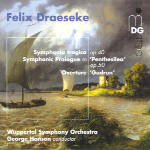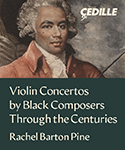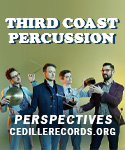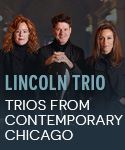Felix Draeseke considered the Symphonia tragica (his Third Symphony) to be his orchestral masterpiece. So did many of his contemporaries. They were wrong. In the first place, there’s nothing especially tragic about it. It operates across a narrow emotional range for much of its length, only waking up for a finale that arrives at a somewhat strained climax (featuring the work’s only cymbal crash). Unfortunately, this is marred by an overly prominent piccolo part that gives an unintentionally melodramatic, almost comic touch to what the composer clearly intended to be the symphony’s grandly impressive highpoint. The very opening sounds like Beethoven’s Leonore Overture No. 3 with faulty ignition, and a few rhythmic outbursts from the timpani in the slow movement do not an effective funeral march make. So far Draeseke’s finest symphonic effort seems to be the comparatively light-hearted and jolly Symphony No. 2, recently issued on CPO.
The overture to the opera Gudrun is so forgettable that you may think you suffered an 11-minute seizure or blackout while it was playing. On the other hand, the Symphonic Prologue to Penthesilea is a masterpiece, as fine a tone poem as Liszt never wrote. Surging rhythms, characterful scoring (including much freer use of brass and percussion than in the symphony), and distinctive thematic material accurately chart the downfall of the Kleist’s Amazon Queen heroine within the framework of a tightly argued sonata structure. The last bars, with their sharp orchestral exclamations against a mournful, quiet background have genuine originality of conception and make a powerful impression. It’s such a pity that Draeseke allowed his anal retentive impulses to so often rein in his creative energy, but then in the late 19th century he was hardly alone in this regard.
Unlike their flat recording of the First Symphony and Piano Concerto, George Hanson and the Wuppertal Symphony really wake up this time around and deliver fine accounts of all three works. In the symphony, Hanson offers substantially identical tempos to the only competition (on CPO), but presents a better-focused conception with sharper, more powerfully shaped climaxes (relatively speaking). There’s no competition for Gudrun, not that it would matter much if there were, but Hanson and his players make an extremely impressive statement in Penthesilea, generating plenty of excitement on the way to the music’s brooding resolution. MDG’s recorded sound has plenty of impact and opens out nicely in louder passages. Draeseke was indeed an uneven composer, and you might respond to the Tragica’s thin-blooded Romanticism more positively than I do, but you definitely should try to hear Penthesilea. It deserves to return to the active repertoire.
































